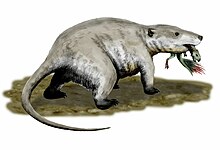Репеномамы: различия между версиями
← Новая страница: «{{Subst:L}} {{taxobox | name = {{вымер}} ''Repenomamus'' | image file = Repenomamus giganticus skull.JPG | image descr = Череп ''Repeno...» |
(нет различий)
|
Версия от 21:56, 22 ноября 2011
Эту страницу в данный момент активно редактирует участник Dmitri Lytov. |
† Repenomamus | ||||||||||||
|---|---|---|---|---|---|---|---|---|---|---|---|---|
| Научная классификация | ||||||||||||
|
||||||||||||
| Латинское название | ||||||||||||
| Не указано международное название Вы можете помочь проекту, поставив latin=название внутри шаблона taxobox в тексте статьи |
||||||||||||
| Species | ||||||||||||
Repenomamus robustus | ||||||||||||
|
|
[[Категория:Animalia по алфавиту]]


Репеномамус, лат. Repenomamus — крупнейший из млекопитающих мелового периода, найденный в Манчжурии. Употреблял в пищу динозавров, однако на данный момент невозможно с точностью сказать, был ли он охотником или падальщиком.
Палеобиология
Repenomamus was probably not a fast runner. The humerus and femur left their joints at a somewhat splayed angle, and the legs were relatively short compared to the body. The feet were plantigrade. Repenomamus's behavior and overall body shape may have resembled those of modern day Tasmanian devils.
Repenomamus was carnivorous. A specimen of R. robustus has been discovered with the fragmentary skeleton of a juvenile Psittacosaurus preserved in its stomach. This is the strongest evidence that Mesozoic mammals fed on dinosaurs, creating interest in the popular press. There were, however, earlier indications that Mesozoic mammals fed on dinosaurs (see Archaeornithoides).[1]
Размер
The larger species, R. giganticus, holds the distinction of being the largest mammal known from the Cretaceous. A few other described mammals, such as an early giant platypus, Kollikodon, may have been larger, but they are only known from small fragments so their actual size is in question. R. giganticus was more than 1 m (39 in) long and weighed about 12—14 kg (26—31 lb). Its skull measures 16 cm (6.25 in) long, its body 52 cm (20.5 in), and the preserved part of its tail 36 cm (14 in). The other species, R. robustus, was less than 50 cm (20 in) long and weighed 4—6 kg (9—13 lb). These finds are considered important, because they expand the ecological niches known to be inhabited by mammals during the 150 million year reign of the dinosaurs. Previously, the only known mammals of this time period were small nocturnal insectivores, not unlike modern-day shrews. It had been assumed the niches of animals more than 1 m (39 in) long were filled entirely by dinosaurs and reptiles like crocodilians, and were off limits to mammals until after the Cretaceous-Tertiary extinction event wiped out the dinosaurs and allowed the diversification of mammals during the Cenozoic. Repenomamus disproves this.
R. giganticus is larger than a number of species of feathered dinosaurs also from the same rock formation in China, including Sinornithosaurus, Caudipteryx and Mei.
Классификация и открытие
The fossils were recovered from the lagerstätte of the Yixian Formation in the Liaoning province of China, which is renowned for its extraordinarily well-preserved fossils of feathered dinosaurs. They have been specifically dated to 130 million years ago, during the Early Cretaceous period.
Repenomamus is a genus of triconodonts, a group of early mammals with no modern relatives. R. robustus was described by Li, Wang, Wang and Li in 2000, and R. giganticus was described by Hu, Meng, Wang, Li 2005. The two known species are the sole members of the family Repenomamidae, which was also described in the same paper in 2000. It is sometimes alternatively listed as a member of the family Gobiconodontidae; although this assignment is controversial, a close relationship to this family is well-founded.
Литература
- J. Li, Y. Wang, Y. Wang, & C. Li (2001). "A new family of primitive mammal from the Mesozoic of western Liaoning, China". Chinese Science Bulletin. 46 (9): 782—785. doi:10.1007/BF03187223. ISSN 1001-6538.
{{cite journal}}: Шаблон цитирования имеет пустые неизвестные параметры:|month=(справка)Википедия:Обслуживание CS1 (множественные имена: authors list) (ссылка) - Yaoming Hu, Jin Meng, Yuanqing Wang, Chuankui Li (2005). "Large Mesozoic mammals fed on young dinosaurs". Nature. 433 (7022): 149—152. doi:10.1038/nature03102. PMID 15650737.
{{cite journal}}: Шаблон цитирования имеет пустые неизвестные параметры:|month=(справка)Википедия:Обслуживание CS1 (множественные имена: authors list) (ссылка)
Примечания
- ↑ Elzanowski, Andrzej, Wellnhofer, Peter. (1993) «Skull of Archaeornithoides from the Upper Cretaceous of Mongolia» «American Journal of Science» Vol. 293-A-A, pp.235-252
Ссылки
- «Prehistoric badger had dinosaurs for breakfast». Michael Hopkin. Nature.com. January 12, 2005.
- «Fierce mammal ate dinos for lunch». BBC News. January 12, 2005.
